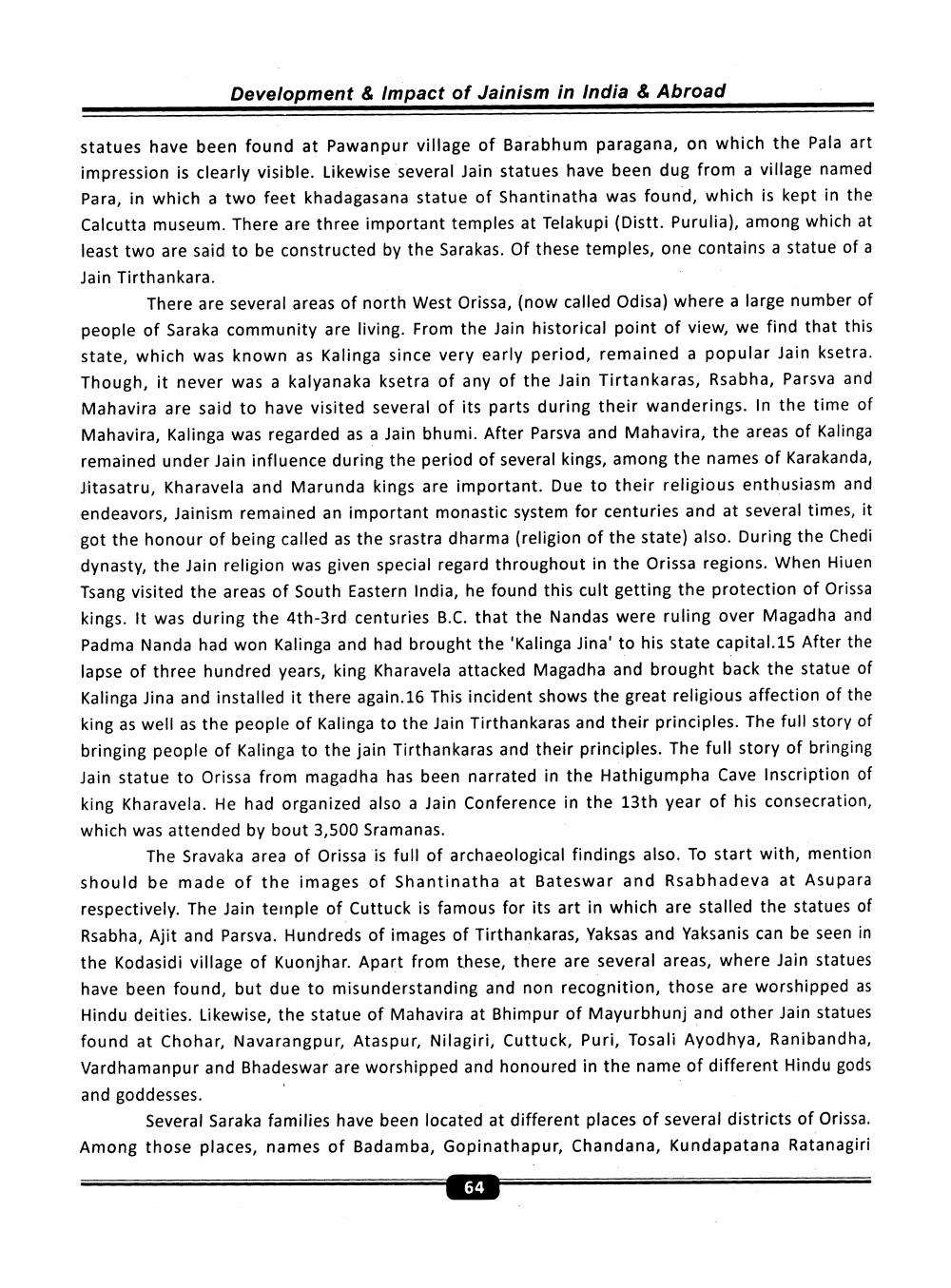________________
Development & Impact of Jainism in India & Abroad
statues have been found at Pawanpur village of Barabhum paragana, on which the Pala art impression is clearly visible. Likewise several Jain statues have been dug from a village named Para, in which a two feet khadagasana statue of Shantinatha was found, which is kept in the Calcutta museum. There are three important temples at Telakupi (Distt. Purulia), among which at least two are said to be constructed by the Sarakas. Of these temples, one contains a statue of a Jain Tirthankara.
There are several areas of north West Orissa, (now called Odisa) where a large number of people of Saraka community are living. From the Jain historical point of view, we find that this state, which was known as Kalinga since very early period, remained a popular Jain ksetra. Though, it never was a kalyanaka ksetra of any of the Jain Tirtankaras, Rsabha, Parsva and Mahavira are said to have visited several of its parts during their wanderings. In the time of Mahavira, Kalinga was regarded as a Jain bhumi. After Parsva and Mahavira, the areas of Kalinga remained under Jain influence during the period of several kings, among the names of Karakanda, Jitasatru, Kharavela and Marunda kings are important. Due to their religious enthusiasm and endeavors, Jainism remained an important monastic system for centuries and at several times, it got the honour of being called as the srastra dharma (religion of the state) also. During the Chedi dynasty, the Jain religion was given special regard throughout in the Orissa regions. When Hiuen Tsang visited the areas of South Eastern India, he found this cult getting the protection of Orissa kings. It was during the 4th-3rd centuries B.C. that the Nandas were ruling over Magadha and Padma Nanda had won Kalinga and had brought the 'Kalinga Jina' to his state capital.15 After the lapse of three hundred years, king Kharavela attacked Magadha and brought back the statue of Kalinga Jina and installed it there again. 16 This incident shows the great religious affection of the king as well as the people of Kalinga to the Jain Tirthankaras and their principles. The full story of bringing people of Kalinga to the jain Tirthankaras and their principles. The full story of bringing Jain statue to Orissa from magadha has been narrated in the Hathigumpha Cave Inscription of king Kharavela. He had organized also a Jain Conference in the 13th year of his consecration, which was attended by bout 3,500 Sramanas.
The Sravaka area of Orissa is full of archaeological findings also. To start with, mention should be made of the images of Shantinatha at Bateswar and Rsabhadeva at Asupara respectively. The Jain ternple of Cuttuck is famous for its art in which are stalled the statues of Rsabha, Ajit and Parsva. Hundreds of images of Tirthankaras, Yaksas and Yaksanis can be seen in the Kodasidi village of Kuonjhar. Apart from these, there are several areas, where Jain statues have been found, but due to misunderstanding and non recognition, those are worshipped as Hindu deities. Likewise, the statue of Mahavira at Bhimpur of Mayurbhunj and other Jain statues found at Chohar, Navarangpur, Ataspur, Nilagiri, Cuttuck, Puri, Tosali Ayodhya, Ranibandha, Vardhamanpur and Bhadeswar are worshipped and honoured in the name of different Hindu gods and goddesses.
Several Saraka families have been located at different places of several districts of Orissa. Among those places, names of Badamba, Gopinathapur, Chandana, Kundapatana Ratanagiri
64




